Every child is unique, with their distinct learning style, pace, and preferences. The Montessori approach to education, renowned for its adaptability, is perfectly suited to accommodate these individual differences. In this article, we will explore how the Montessori philosophy can be personalized to cater to various learning styles and preferences, providing a rich and customized educational experience. At Montessori Australia, you'll find resources that support this flexible approach to learning.
1. Understanding Learning Styles

Before we delve into how Montessori can cater to different learning styles, let's briefly explore the main types of learning styles:
-
Visual Learners: Visual learners absorb information best through visual aids like charts, diagrams, and images. They benefit from seeing information presented in a clear and organized manner.
-
Auditory Learners: Auditory learners learn best through listening. They thrive in environments where information is presented through spoken words, discussions, and lectures.
-
Kinesthetic Learners: Kinesthetic learners are hands-on learners who understand concepts through physical engagement and movement. They prefer learning by doing.
-
Read/Write Learners: Read/write learners grasp information best through reading and writing. They excel in traditional academic settings, where textbooks and note-taking are prevalent.
2. Montessori Materials for Visual Learners

Montessori classrooms are equipped with a wide array of materials that cater to visual learners. Materials like the Moveable Alphabet, Sandpaper Letters, and Geometric Solids incorporate tactile and visual elements, making it easier for visual learners to absorb concepts.
3. Encouraging Exploration for Kinesthetic Learners

Kinesthetic learners thrive in Montessori environments, where hands-on exploration is at the core of learning. Materials such as the Pink Tower, Cylinder Blocks, and the Hundred Board allow kinesthetic learners to manipulate objects and engage in physical activities to understand concepts deeply.
4. Verbal and Social Interaction for Auditory Learners

Auditory learners benefit from discussions, group activities, and opportunities for verbal expression. Montessori classrooms often encourage peer interaction and collaborative learning, which align well with the preferences of auditory learners.
5. Incorporating Journaling for Read/Write Learners

Read/write learners can excel in Montessori settings by incorporating journaling and note-taking into their learning experiences. Encourage these learners to record their observations, thoughts, and questions in a journal.
6. Individualized Learning Plans

Montessori classrooms often use individualized learning plans (ILPs) to tailor education to each child's specific needs. These plans can be adjusted to accommodate a child's learning style, ensuring that they receive the support and resources they need.
7. Self-Paced Learning

One of the key principles of Montessori education is self-paced learning. This approach allows children to progress through materials and activities at their own speed, ensuring that they have the time they need to master concepts according to their learning style.
8. A Variety of Learning Materials

Montessori classrooms offer a diverse range of learning materials and activities, allowing children to choose what interests them most. This variety caters to different learning styles and encourages children to explore areas that align with their preferences.
9. Personalized Guidance from Montessori Educators

Montessori educators are trained to observe and understand each child's unique learning style. They provide personalized guidance, adapting their teaching methods to match the child's preferences and needs.
10. Embracing Multi-Sensory Learning

The Montessori method promotes multi-sensory learning experiences. Many materials engage multiple senses simultaneously, accommodating various learning styles and ensuring a well-rounded educational experience.
11. Encouraging Self-Awareness

The Montessori approach encourages children to become self-aware learners. Through self-reflection and self-assessment, children can identify their preferred learning styles and use this knowledge to approach their education more effectively.
12. Supporting Holistic Development

Montessori education focuses not only on academic development but also on the holistic growth of the child. This includes emotional, social, and physical development, ensuring that every aspect of a child's unique learning style is nurtured.
13. Creating a Nurturing Environment

The Montessori classroom is designed to be a nurturing and non-competitive space. This environment allows children to feel comfortable exploring their learning styles without fear of judgment.
14. Flexibility in Lesson Planning

Montessori educators have the flexibility to adapt lesson plans based on the learning styles of their students. This adaptability ensures that each child's needs are met.
Conclusion
The Montessori approach to education is exceptionally well-suited to cater to the diverse learning styles and preferences of children. By embracing hands-on exploration, individualized learning plans, and a variety of learning materials, Montessori education ensures that each child can thrive according to their unique strengths and preferences. At Montessori Australia, you can discover resources and materials that support this personalized and adaptable approach to education, fostering a love for learning that lasts a lifetime. Montessori doesn't just teach children; it empowers them to become self-aware, self-directed, and confident learners who embrace their individuality and unique learning styles.

